Shade gardeners seem to have more garden envy than any group of gardeners I know. They drool over dahlias, linger over lantana and swoon over salvias, knowing deep down that these plants would soon meet their demise beneath the shadowy canopy of their woodland spaces. The good news is that a shade garden can be the most deeply satisfying garden of all.
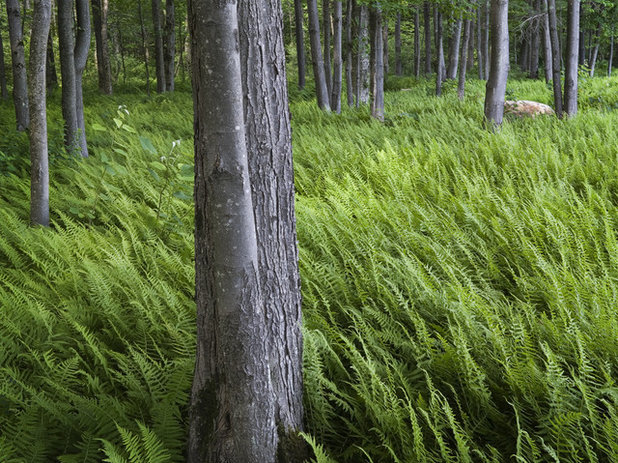
Crisp Architects
Ferns immediately come to mind when we think of shade gardens, and for good reason. They have been on Earth for more than 300 million years. Most ferns inhabit temperate and tropical forests, where they flourish in shady, moist and humid conditions. There is something primally satisfying about this diverse group of plants, which is reason enough to include them in almost any environment in which they will grow.
There are, however, many other reasons to plant ferns. Let’s take a look at eight of them.

Jay Sifford Garden Design
1. Plant en masse for a soothing experience. Probably the No. 1 way to create drama in a garden is to limit the plant palette and install large quantities of those plants. My motto is this: Why plant one when you could just as well plant 50? Ferns, in particular, lend themselves to planting en masse because of their unique form and texture. If the group can be installed in a serpentine pattern, so much the better. Serpentine shapes have a relaxing effect on the brain.
Notice how effective this mass planting of
Korean traveler ferns (
Thelypteris beddomei ‘Korean Traveler’, USDA zones 6 to 9) is in this woodland garden. Also notice how this planting lifts the eye and dramatically emphasizes the Japanese maple in the background.
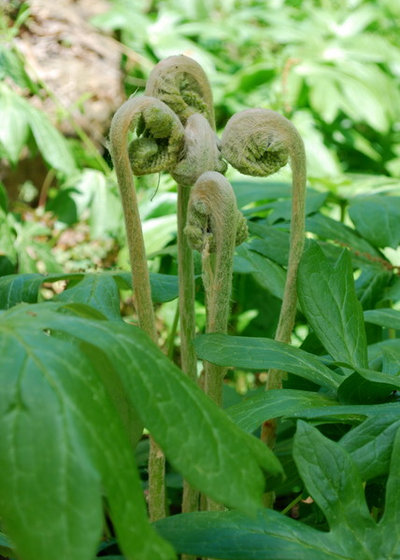
Jay Sifford Garden Design
2. Plant for seasonal interest. A static garden can become a stale garden. A successful one celebrates the seasons in both bold and subtle ways. Nothing says spring better than young fiddleheads emerging after a long winter.
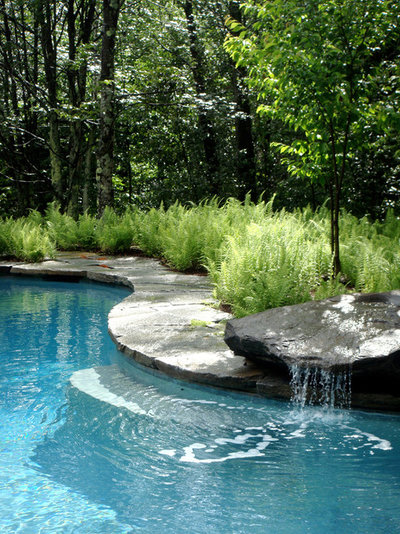
Shepard Butler Landscape Architecture
3. Plant for a suitable transition. How to soften borders and create appropriate transitions between spaces is a common garden dilemma. Since ferns range in height from 6 inches to more than 6 feet, they can be invaluable in this regard. This garden shows how beautifully ferns can ease the transition between hardscaping and a forested area.
Read more about gardens planted on the edge of nature
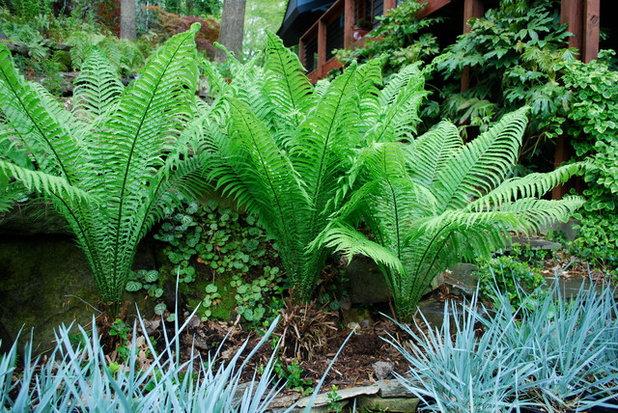
Jay Sifford Garden Design
4. Plant for architectural interest. Plants with good structure are standouts among the usual array of ground covers found in most shade gardens. Fortunately there are many ferns that fit the bill. Notice the beautiful vase-like structure of these ostrich ferns (
Matteuccia struthiopteris, zones 3 to 7).
When planting ferns with architectural interest, be sure not to plant them too closely together. Proper spacing will allow them to be seen to best advantage.
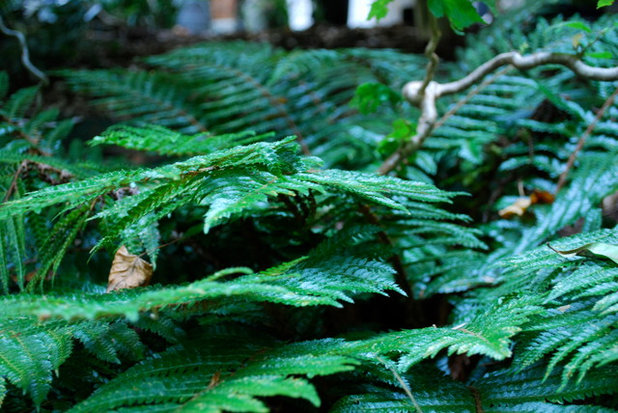
Jay Sifford Garden Design
5. Plant to emphasize layering. The layered growth habit of certain ferns, such as this
tassel fern (
Polystichum polyblepharum,
zones 5 to 8), provides unexpected interest in a shade garden. They can be used to create a focal point around the bend in a pathway or can really shine if planted on a slope at eye level.

Jay Sifford Garden Design
6. Plant for textural interest. Few plants exhibit texture to the degree that ferns do. A frequent complaint regarding shade gardens is that there is little color other than the ever-present green. This perceived shortcoming can be used to great advantage, because the absence of competing colors causes the eye to notice subtler but equally beautiful things such as form and texture.
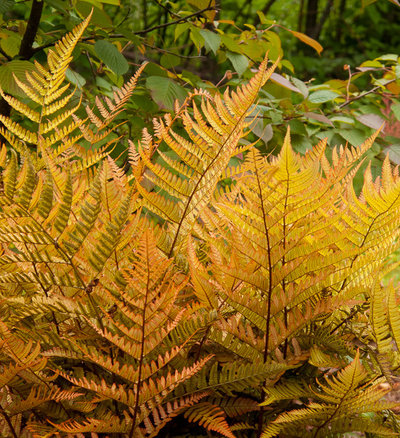
Le jardinet
This is not to say that ferns do not exhibit beautiful variations in color. These autumn ferns (
Dryopteris erythrosora,
zones 5 to 9) are a breathtaking case in point. The growth on these ferns emerges as a beautiful bronzy orange before turning light green. Colorful new growth continues to emerge sporadically throughout the growing season.
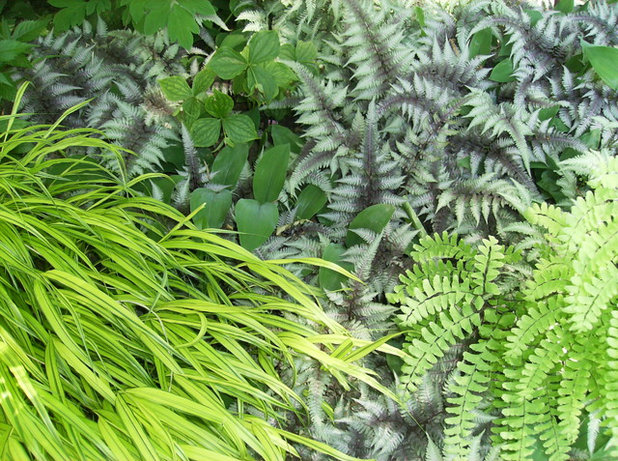
A J Miller Landscape Architecture PLLC
7. Plant for contrast. Good garden designers know how to create interest through juxtaposition. By considering shape, size, color and texture, and grouping several plants with two common and two different characteristics together, you can create visual excitement in your garden.
Read more about mixing things up in the landscape
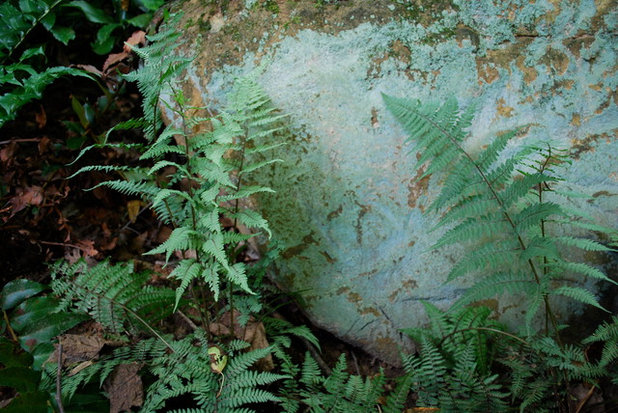
Jay Sifford Garden Design
8. Plant to emphasize garden subtleties. Look around your space and take note of its best characteristics. Woodland gardens are generally full of beautiful components that deserve to be noticed. Perhaps you will find a formation of boulders or a stand of vertical trees. By thoughtfully planting around these features, you can give them the attention they deserve. Notice how the natural coloration of this boulder is dramatically reinforced by the
ghost ferns (
Athyrium ‘Ghost’, zones 3 to 8).
More: 6 Beautiful Plants for a Shady, Wet Site





